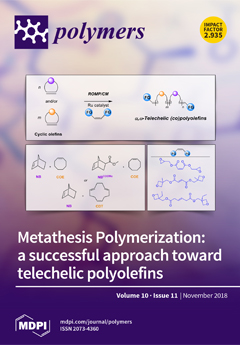The water molecule migration and aggregation behaviors in oil-impregnated pressboard are investigated by molecular dynamics simulations in combination with Monte Carlo molecular simulation technique. The free energy and phase diagram of H
2O-dodecylbenzene (DDB) and H
2O-cellulose mixtures are calculated by
[...] Read more.
The water molecule migration and aggregation behaviors in oil-impregnated pressboard are investigated by molecular dynamics simulations in combination with Monte Carlo molecular simulation technique. The free energy and phase diagram of H
2O-dodecylbenzene (DDB) and H
2O-cellulose mixtures are calculated by Monte Carlo technique combined with the modified Flory-Huggins model, demonstrating that H
2O molecules can hardly dissolved with infinitesimal content in cellulose system at temperature lower than 650 K, based on which the oil/cellulose layered structure with water impurity representing three-phase coexistence in oil-impregnated pressboard are modeled and performed for molecular dynamics. The molecular dynamics of H
2O/DDB/cellulose three-phase mixture simulating oil-paper insulating system with H
2O impurity indicates that DDB molecules can thermally intrude into the cellulose-water interface so as to separate the water phase and cellulose fiber. The first-principles electronic structure calculations for local region of H
2O/DDB interface show that H
2O molecules can introduce bound states to trap electrons and acquire negative charges, so that they will obtain sufficient energy from applied electric field to break DDB molecular chain by collision, which are verified by subsequent molecular dynamics simulations of H
2O
−/DDB interface model. The electric breakdown mechanism under higher than 100 kV/m electric field is presented based on the further first-principles calculations of the produced carbonized fragments being dissolved and diffusing in DDB phase. The resulted broken DDB fragments will introduce impurity band between valence and conduction bands of DDB system, evidently decreasing bandgap as to that of conducting materials in their existence space. The conductance channel of these carbonized DDB fragments will eventually be formed to initiate the avalanche breakdown process by the cycle-feedback of injected charge carriers with carbonized channels.
Full article






